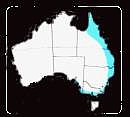Photography by Steve Solomons. Site by Weblight Studio (Australia) All Rights reserved
Black-faced Cuckoo Shrike
Black-Backed Magpie
Chestnut Teal
Crested Pigeon
Domestic Pigeon
Eastern Rosella
Figbird
Galah
Little Corella
Noisy Miners
Rainbow Lorikeets
Grey Butcher Bird

Scaley Breasted Lorikeet

Rainbow Lorikeet
Trichoglossus haemotadus
DISTRIBUTION: Eastern Australia from Cape York south to Tasmania and west to Kangaroo Island and Eyre Peninsula, SA; introduced around Perth WA. Also Indonesia, New Guinea, Solomon Islands, Vanuatu, New Caledonia
NOTES: Also called Blue Mountain Parrot and Bluey. In flocks, frequenting flowering eucalypts, often in the company of the Scaly-Breasted Lorikeet. Gathers in flocks to roost, from which points flocks may travel considerable distances seeking blossum laden trees. Calls include high-pitched chattering notes and a sharp shrill screetch when on the wing. This beautiful bird sometimes causes damage in orchards. In some areas flocks visit houses and can be hand-fed. Food: Nectar, pollen, flowers, and native and cultivated fruit and grain.
NEST: In a hole in a tree.
EGGS: Two; white. Breeding-season: usually Sept to Jan.


Personal Notes
Rainbow Lorikeets make an ear-splitting racket, chattering incessently as they feed. They are exhuberant to the point of being manic as they fly like coloured missiles through the trees.
I have been seen them fly along a street running parallel to the sea during a gale. As they hit a side street and caught the blast of the wind they whirled wildly into the air screeching at each other as though calling to see who was having the most fun.
references from What Bird is That?
Neville W. Cayley. 1931 revised by Terence Lyndsey. 1984 ...Angus and Robertson, Sydney Australia